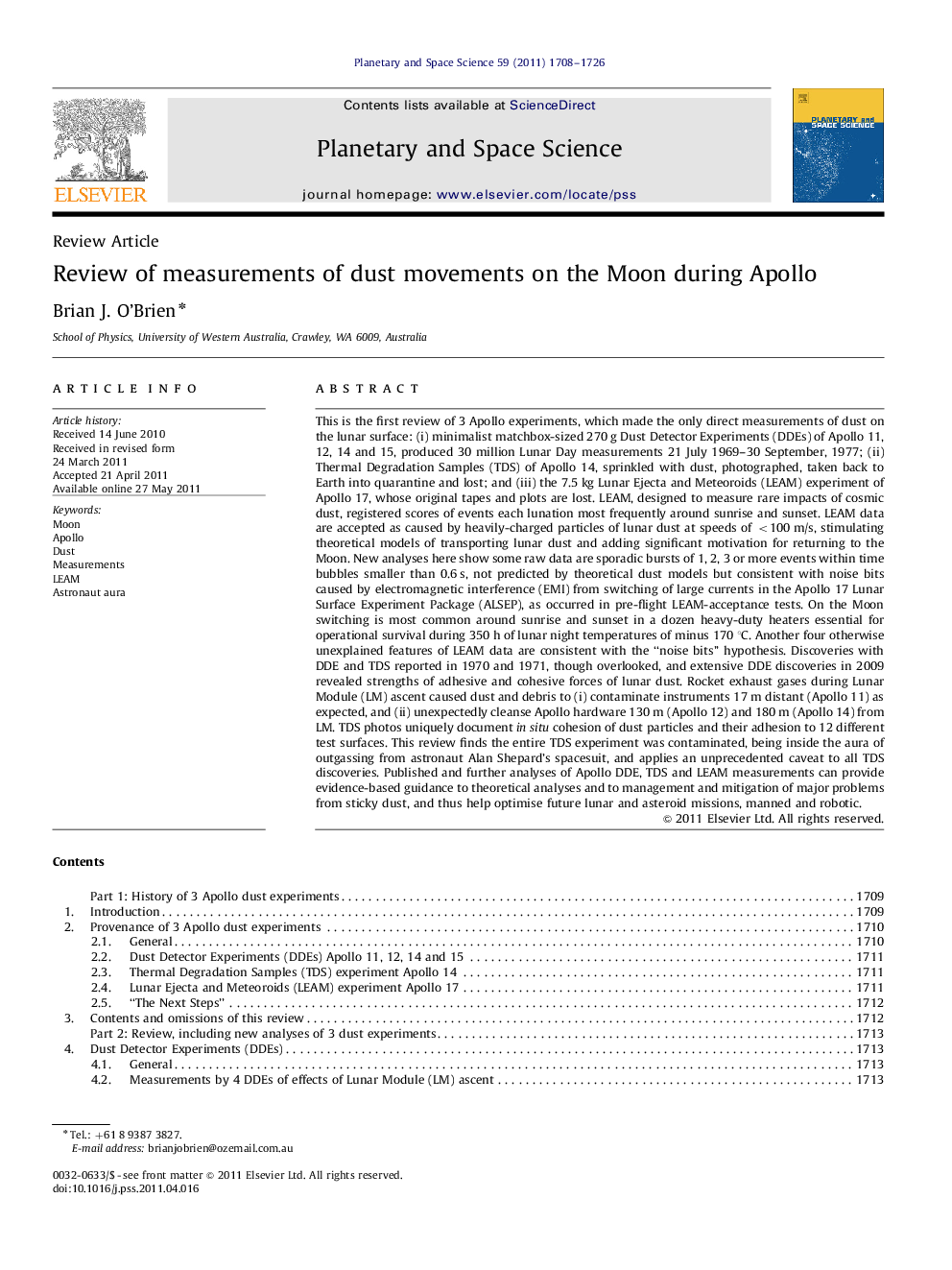| کد مقاله | کد نشریه | سال انتشار | مقاله انگلیسی | نسخه تمام متن |
|---|---|---|---|---|
| 1781624 | 1022293 | 2011 | 19 صفحه PDF | دانلود رایگان |

This is the first review of 3 Apollo experiments, which made the only direct measurements of dust on the lunar surface: (i) minimalist matchbox-sized 270 g Dust Detector Experiments (DDEs) of Apollo 11, 12, 14 and 15, produced 30 million Lunar Day measurements 21 July 1969–30 September, 1977; (ii) Thermal Degradation Samples (TDS) of Apollo 14, sprinkled with dust, photographed, taken back to Earth into quarantine and lost; and (iii) the 7.5 kg Lunar Ejecta and Meteoroids (LEAM) experiment of Apollo 17, whose original tapes and plots are lost. LEAM, designed to measure rare impacts of cosmic dust, registered scores of events each lunation most frequently around sunrise and sunset. LEAM data are accepted as caused by heavily-charged particles of lunar dust at speeds of <100 m/s, stimulating theoretical models of transporting lunar dust and adding significant motivation for returning to the Moon. New analyses here show some raw data are sporadic bursts of 1, 2, 3 or more events within time bubbles smaller than 0.6 s, not predicted by theoretical dust models but consistent with noise bits caused by electromagnetic interference (EMI) from switching of large currents in the Apollo 17 Lunar Surface Experiment Package (ALSEP), as occurred in pre-flight LEAM-acceptance tests. On the Moon switching is most common around sunrise and sunset in a dozen heavy-duty heaters essential for operational survival during 350 h of lunar night temperatures of minus 170 °C. Another four otherwise unexplained features of LEAM data are consistent with the “noise bits” hypothesis. Discoveries with DDE and TDS reported in 1970 and 1971, though overlooked, and extensive DDE discoveries in 2009 revealed strengths of adhesive and cohesive forces of lunar dust. Rocket exhaust gases during Lunar Module (LM) ascent caused dust and debris to (i) contaminate instruments 17 m distant (Apollo 11) as expected, and (ii) unexpectedly cleanse Apollo hardware 130 m (Apollo 12) and 180 m (Apollo 14) from LM. TDS photos uniquely document in situ cohesion of dust particles and their adhesion to 12 different test surfaces. This review finds the entire TDS experiment was contaminated, being inside the aura of outgassing from astronaut Alan Shepard's spacesuit, and applies an unprecedented caveat to all TDS discoveries. Published and further analyses of Apollo DDE, TDS and LEAM measurements can provide evidence-based guidance to theoretical analyses and to management and mitigation of major problems from sticky dust, and thus help optimise future lunar and asteroid missions, manned and robotic.
► This first review of all Apollo dust experiments also challenges 40-year beliefs.
► Our new analyses discovered Apollo 17 LEAM raw data occur within 0.6 s bursts.
► We show causes of iconic LEAM data more consistent with noise bursts than Moon dust.
► Our 4 Dust Detectors have made 9 discoveries to date from 30 million measurements.
► Unique Thermal Degradation Samples photos reveal dust cohesion as well as adhesion.
Journal: Planetary and Space Science - Volume 59, Issue 14, November 2011, Pages 1708–1726